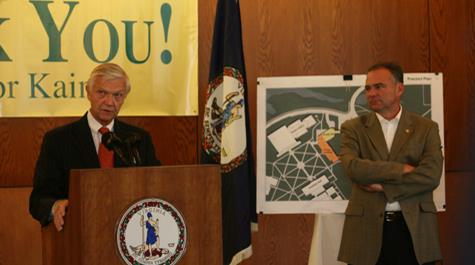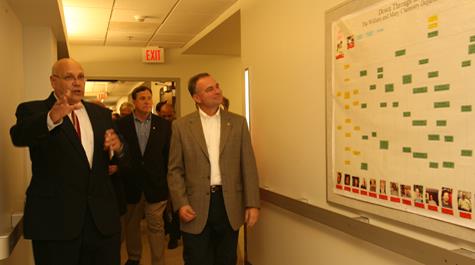Gov. Kaine tours College's ISC
Virginia Gov. Timothy M. Kaine toured William and Mary's new Integrated Science Center on Wednesday, visiting some labs, speaking about budgetary challenges and capped his visit by sampling some of the chemistry department's traditional lab-made ice cream.
The visit to William and Mary was a stop on the governor's Cabinet Community Day, a quarterly informational road trip to various places in the Commonwealth. In the Integrated Science Center, Kaine was joined by several members of his cabinet, along with Williamsburg Mayor Jeanne Zeidler, College Rector Michael K. Powell and Timothy Dunn '83, a new Kaine appointee to William and Mary's Board of Visitors.
Kaine spoke about William and Mary's research contributions, noting in particular "the great work that is being done at VIMS," in support of Virginia's important seafood industries. He also spoke of budgetary decisions to be made in the time of declining revenue, and the importance of to maintaining a strong higher-education system.
"I deeply understand that in a time of economic challenges, investments in education—peculiarly higher education—probably have the most immediate return in terms of economic growth for the Commonwealth," the governor said.
Kaine pointed out a state bond package recently arranged, in which he said "the lion's share went to higher ed," in support of capital projects such as the Integrated Science Center. The recently adopted capital plan includes $38.1 million to fully fund construction of the College’s future School of Education building as well as $250,000 in pre-planning dollars for the third phase of the ISC. "Thank you" banners acknowledged the state's support for the first two phases of ISC facility, which are being paid for through a combination of state, private and College funds.
Interim President W. Taylor Reveley III and Provost P. Geoffrey Feiss welcomed the governor to William & Mary and the ISC.
"The state has made a real difference in the life of this university," Reveley said in opening remarks in the ISC 1 lobby, "and this university has made a real difference in the life of the Commonwealth of Virginia. William and Mary is renowned as a great teaching institution; everybody in the galaxy understands that William and Mary is a great teaching institution, but less well known in some parts of the galaxy is that William and Mary is a very great research institution."
Dennis Manos, vice provost for research at William and Mary, led Kaine and his entourage through the ISC, which contains not only the entire chemistry department, but also a substantial portion of biology's labs, classrooms and faculty offices. The psychology department will occupy ISC 2, once it's finished in 2009, along with more biologists, moving over from Millington Hall. ISC 3, now being planned, will hold "things that we don't even have names for, yet" Manos said.
Kaine and his entourage admired the new labs and working areas in ISC 1. He stopped in the chemistry lab of J.C. Poutsma, who uses mass spectrometry to study the reactivity and stability of a variety of chemical compounds, especially amino acids, an important group of chemicals that are the building blocks of proteins. On the third floor of ISC 1, Kaine visited the lab of Margaret Saha, who leads a group that studies genetics and cellular biology related to the development of the nervous system in vertebrates.
In each lab, Kaine heard a brief synopsis of the type of work. Saha showed the governor some photos of her old lab in Millington, which was subject to flooding in heavy and even moderate rainfall; she expressed her delight with the new facilities in ISC 1. The governor asked a number of questions in each lab, showing particular interest in the students working in both labs.
During the tour, Manos paused at a third-floor corridor window to show the governor the location of the proposed ISC 3, which would describe the hypotenuse of the right angle now made by ISC 1 and Rogers/ISC 2. School of Education Dean Virginia McLaughlin also showed the gathering an artist's rendering of the school's new building, to be constructed on the site of the former Sentara Williamsburg Community Hospital. Rob Hicks, associate professor of economics, gave a presentation on the interdisciplinary Project-Level Aid initiative. Also known as PLAID, Hicks and his colleagues are documenting the flow of hundreds of thousands of foreign aid grants.
It's been a long-standing tradition among William and Mary's chemists to take a break on Wednesday summer afternoons for ice cream, immediately frozen by pouring liquid nitrogen into the mix. The department continued its custom after moving to the new ISC from the adjacent Rogers Hall. Rogers is being transformed into what will become the Integrated Science Center, Phase 2.
To celebrate the gubernatorial visit, Associate Professor of Chemistry Lisa Landino, assisted by a group of students—and Governor Kaine—whipped up two flavors of lab-made ice cream, Oreo and peach. Kaine, eyes protected by lab glasses, added a generous portion of crunched cookies to a smoking, rapidly freezing concoction.
“It’s one thing to shake his hand, but how many people can say they’ve eaten ice cream that’s actually been made by the governor?” said Paul Heideman, chair of the biology department, as he polished off a cup of quick-frozen dessert made with gubernatorial assistance.
 Skip to main content
Skip to main content



